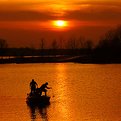
Jeroen Wenting
 (K=25317) - Comment Date 10/2/2004
(K=25317) - Comment Date 10/2/2004
|
colourful sunsets happen mainly when there's a lot of dust or pollutants in the air.
So look for a smoggy day or after a sandstorm (in Northern Europe for example some of the best sunsets occur several days after major sandstorms in northern Africa, it takes that long for the prevailing winds to blow the dust over here).
Having partial cloudcover helps as well, red sun reflecting off the bottom of clouds is magnificent.
|
|
|
|

Joe Stewart
(K=1908) - Comment Date 11/9/2004
|
My best advise to you is to keep going back to catch that one in a million sunset is to Try Try again. One of my favorite spots to catch a sunset is over 15 miles away from my home and even though I never know what the conditions will be when I arrive I go anyway hoping to catch something. I usually look at the clouds an hour or so before the sunset and decide if it's worth making the trip or not. Sunrises are even worse to predict. I have had many a dissapointing morning driving out to the lake in the dark just to find out that I wouldn't be able to catch a good sunrise due to the weather conditions. Whenever I catch a good Sunrise or Sunset, I try diffrent angles, settings, lenses and filters to get that special look.Hopefully I have shed some light on this topic for you
Best Regards
Joe
|
|
|
|

Michael Kanemoto
(K=22115) - Comment Date 11/9/2004
|
Matt:
Guess, and then hope for the best, man.
I've found the best sunsets (and stated somewhat above) in order are:
1. Cloudy day
3. Raining
2. Storm fronts
4. Tornado front
I usually peek up and if I can see clouds coming in, or a weather forecast (or doppler radar) with a storm front I set out and wait from the start of the sunset to dusk.
This gets you half way there, and the rest is total luck. If you get set up, you have to wait for a break in the clouds and the timing may last a few minutes out of the 45 minutes or an hour it takes for the sun to set.
If you want to shoot during a cloudless day, or one without an obscured sun, I'd recommend buying a graduated filter to darken the sky to bring the overall exposure in line with the ground.
Bring a tripod too, since the fading light will have you taking longer and longer exposures.
Lastly, you can always take the photo into a program like Photoshop and independantly mask the sky and darken or get the saturation up. But that's no fun, right?
|
|
|
|

Darie Petrov
(K=397) - Comment Date 12/4/2004
|
The poluated air technique is not AS great as the clean air technique... I mean the colours you get reflected off clouds and fog through crisp air are much better then the ones filtered by polution.
Just gotta see what the air temperature, pressure and humidity are... and derive a formula to know when you will get condensation and or clouds... 
Then you can proceede forth and proove it by induction.
|
|
|
|
















